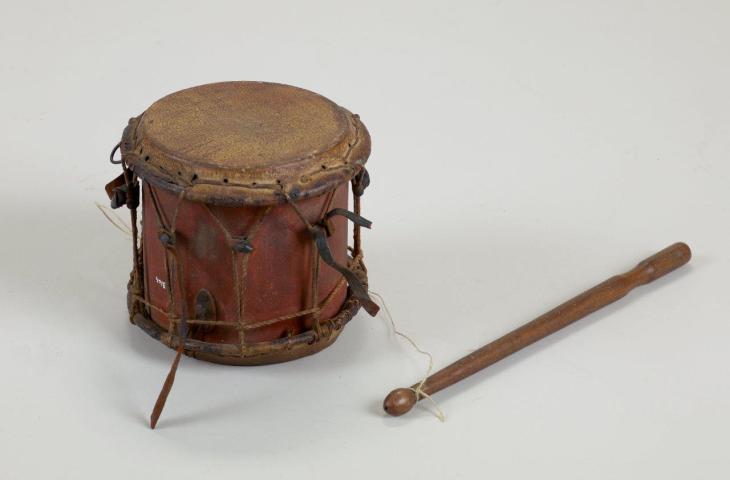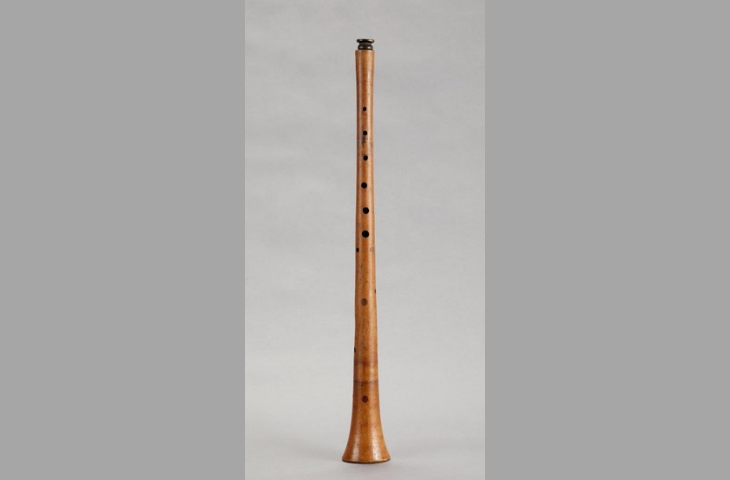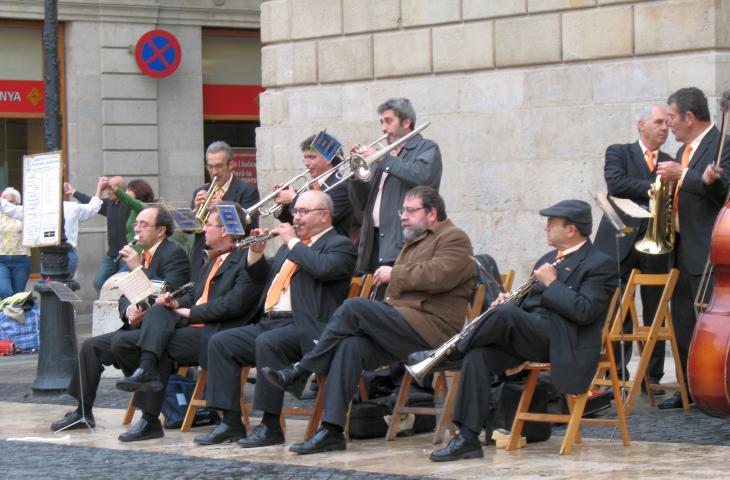October 2022
Fig.1

Flaviol, Catalonia, 1880, inv. 3124
Fig.2

Tamboril, Catalonia, 1880, inv. 3104
Fig.3

Tible, Catalonia, 1800-1900, inv. 3121
Fig.4

Tenora, España Francisco, Catalonia, 1800-1900, inv. 3122
Fig.5

© Túrelio (via Wikimedia-Commons), 2008, Creative Commons CC-BY-SA-3.0-de
An initial interest in Catalan popular instruments
From the time the Brussels Conservatory Instrumental Museum was founded in 1877, Victor-Charles Mahillon, its first curator, showed a keen interest in musical instruments considered to be popular, implicitly opposed to so-called "learned" instruments and often neglected by his colleagues in Paris, Leipzig and elsewhere. Throughout his career, he established a vast international network intended to diversify and enrich the museum's collections.
Thus, at the end of 1909, while living in Saint-Jean-Cap-Ferrat, he came into contact with Miquel S. Gatuellas y Ferrer, secretary of the folklore section of the Centre Excursionista de Catalunya, to acquire various instruments used in Catalan musical traditions. The two men began an intense correspondence, exchanging descriptions, photographs, and technical information about the most characteristic instruments: on the one hand, the gralla (oboe) and timbal (drum) pair, known for accompanying the castells (human pyramids); on the other hand, the instruments forming the cobla - a flabiol/tamborí (fig.1 and 2, one-handed flute and drum), two tiples (fig.3, high oboes), two tenores (fig.4, low oboes), two cornetins á pisté (cornets à pistons or trumpets), two fiscorns (baritone bugles), and a double bass - closely associated with the sardana.
The cobla: a strong symbol of Catalan culture
Mahillon's interest in Catalan musical traditions is probably not accidental. A few decades after the end of the Renaixença - the Catalan renaissance, a romantic movement exalting local popular culture - the cobla, reformed by the famous Pep Ventura during the 19th century, was widely identified as the musical expression par excellence of Catalan culture and enjoyed an international reputation.
At the very moment that Mahillon and Gatuellas were discussing the Catalan orchestra, Déodat de Séverac included it in his lyrical tragedy Héliogabale, which premiered in Béziers in August 1910. Moreover, although Gatuellas was able to state that at the beginning of the century, no museum - public or private - had yet documented the cobla, he had entered into correspondence with A.T. Sinclair of the Smithsonian Institute in Washington, who had acquired various instruments and published an article in the Journal of American Folklore in June 1910. It was precisely through Sinclair that Mahillon came into contact with Gatuellas y Ferrer.
Between authenticity and modernity: the collection approach
Whatever Mahillon's motives for contacting this informant, his approach enabled him to acquire an exceptional collection. Unsurprisingly, the cobla described to him in 1909 is very close to the set of eleven instruments formalized half a century earlier by Pep Ventura - the only thing missing is the trombone - without any reference to certain older forms that sometimes lasted until the 19th century, such as the cobla de tres quartans, which combined the flabiol/tamborí with a tarota (oboe) and a sac de gemecs (bagpipes).
Paradoxically, if Victor-Charles Mahillon and his interlocutor aimed to document a contemporary musical practice, they agreed on the need to collect the oldest possible instruments, as they were perceived as more authentic, giving priority to "typical instruments made by the mountain people". In fact, like classical instruments, Catalan woodwinds underwent a rapid evolution in the second half of the 19th century, particularly due to the addition of keys, more or less numerous depending on the case, and metal bells.
However, although their predecessors were nearly out of use by then, the Brussels curator hoped to acquire instruments that predate these modifications. This is evidenced by Gatuellas' warning on 2 December 1909: "It is almost impossible to find them in their original state of construction, because even in the small villages, [they] have been modernized". It was therefore within the framework of a particular approach, bringing together a modern reference point (the Ventura cobla) and an ancient imagination (the "authentic" instruments of the mountain people), that the Catalan instruments were acquired for the Brussels Instrumental Museum.
Instrument selection and Catalan specificities
In February 1910, having apparently received sufficient information, Victor-Charles Mahillon expressed his intention to acquire four instruments: on the one hand a gralla, on the other a flabiol, a tenora, and a tiple—in other words, the instrumental group that makes up the first rank of the cobla (flute and reeds). It is significant that he did not show interest in the second row of the orchestra (brass and double bass), which is essentially made up of instruments from the brass band and already well documented in the Instrumental Museum. This is particularly true of the fiscorn, a baritone flugelhorn with a horizontal, forward-mounted bell, which seems to have spread beyond Catalonia, despite the claims of Mahillon's interlocutor (inv. 1273).
The flabiol and tamborí are the Catalan variant of the single-handed straight flute and drum, a tradition that spread throughout Europe during the Ancien Régime and which has been preserved in Gascony (flabuta), Provence (galoubet), and many other places. In Catalonia, this instrumental pairing is distinguished by the very small size of the drum, which is fixed under the elbow, and the flute, which is equipped with keys that allow the number of holes to be significantly increased. The tenora and the tiple are pirouetting oboes, played with triangular (double) reeds. They differ mainly in their range and the number of keys (when present): the tenora measures nearly 90 centimetres, the tiple about 60. Despite their gradual modernization towards chromatic playing, their conical bore and triangular reeds have preserved their quality as "high instruments," outdoor instruments designed to emit a powerful and highly timbred sound. Although musically the flabiol/tamborí holds a clear leadership function in the cobla, the oboes are perceived as the most characteristic of the genre, an identification certainly favored by their marked timbre.
Acquisition challenges and instrument dating
Shortly after Mahillon's request, in April 1910, Miquel S. Gatuellas y Ferrer announced that he had found an instrument corresponding to the "true type of old gralla with two silver fringes," used in the past at events of the famous castellers group, the Xiquets de Valls, and already rare at the beginning of the century. In the same month, this instrument was taken to the Instrumental Museum, where it was listed under number 3123 (exhibition room).
The acquisition of the cobla's instruments, however, was more difficult. Gatuellas contacted Pedro Sureda, director of the group of the same name, to act as intermediary. After confirming the difficulty of finding instruments that met Mahillon's requirements for authenticity, Mahillon set out to visit the Empordà (north of Gerona) in May and June 1910.
In Olot, he bought a flabiol and a tamborí "about thirty years old"; in Figueres, a tenora "a hundred years old, very primitive without a metal trumpet"; and in Sant Feliu de Pallerols, a tiple "without metal keys and all in one piece [...] even older than the tenora". These four cobla instruments entered the collections of the Brussels museum in July of that year. If we are to believe - with all due caution - the dates given by Victor-Charles Mahillon's informants, these instruments are among the oldest specimens preserved in a museum: before 1810 for the tiple (inv. 3121), around 1850 for the tenora (inv. 3122), and 1880 for the flabiol/tamborí (inv. 3104/3124).
Text: Fañch Thoraval